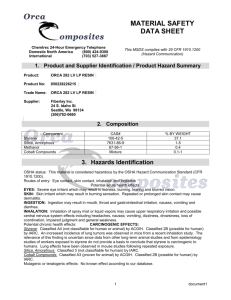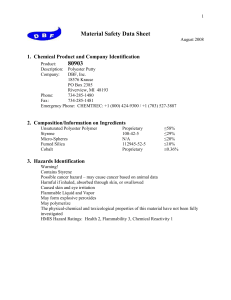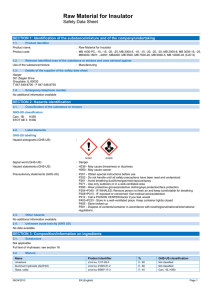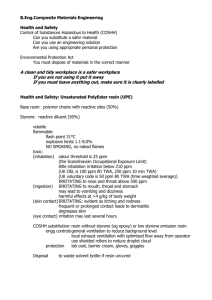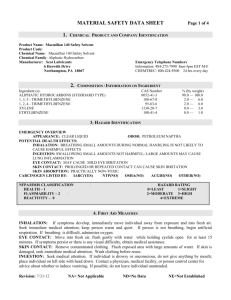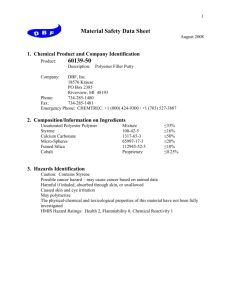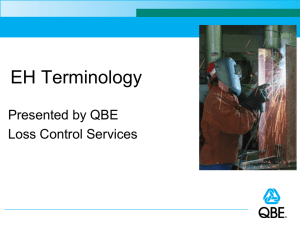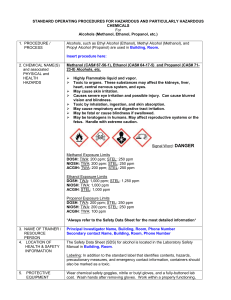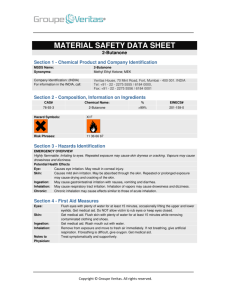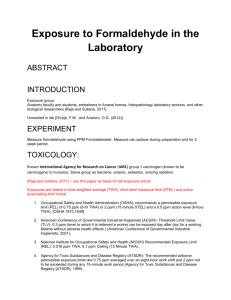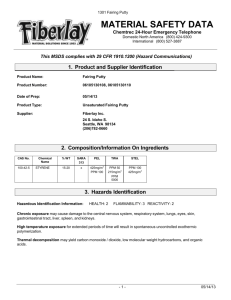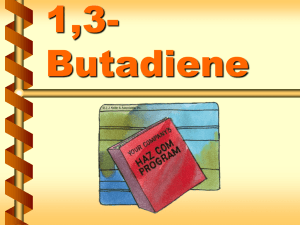material safety data sheet
advertisement
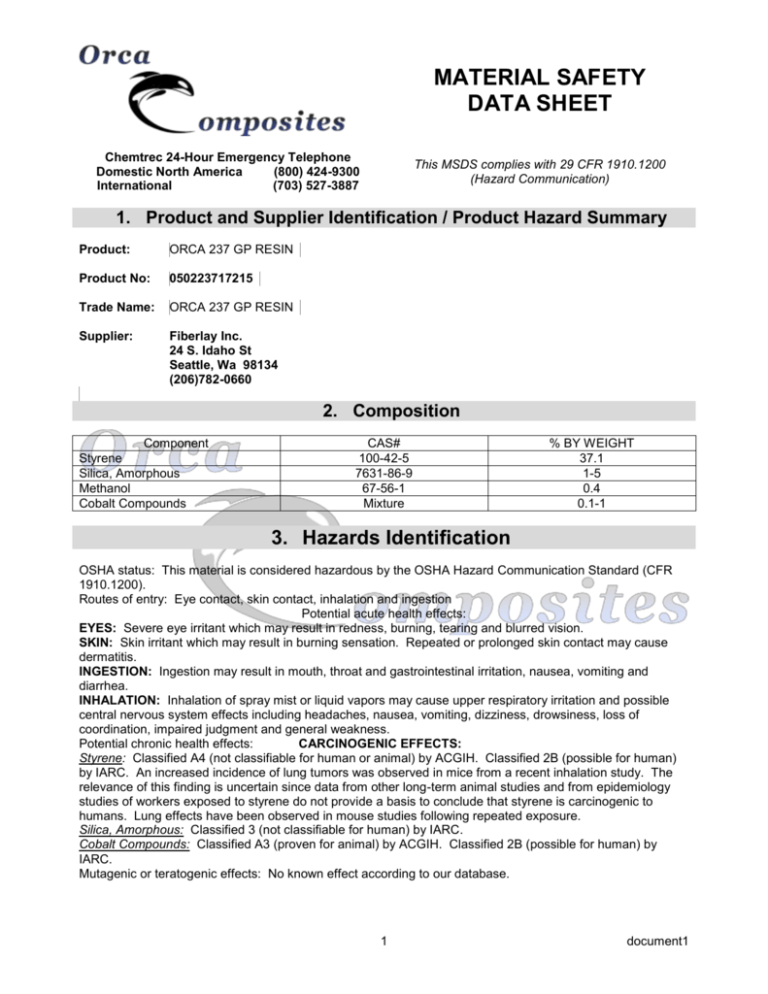
MATERIAL SAFETY DATA SHEET Chemtrec 24-Hour Emergency Telephone Domestic North America (800) 424-9300 International (703) 527-3887 This MSDS complies with 29 CFR 1910.1200 (Hazard Communication) 1. Product and Supplier Identification / Product Hazard Summary Product: ORCA 237 GP RESIN Product No: 050223717215 Trade Name: ORCA 237 GP RESIN Supplier: Fiberlay Inc. 24 S. Idaho St Seattle, Wa 98134 (206)782-0660 2. Composition Component Styrene Silica, Amorphous Methanol Cobalt Compounds CAS# 100-42-5 7631-86-9 67-56-1 Mixture % BY WEIGHT 37.1 1-5 0.4 0.1-1 3. Hazards Identification OSHA status: This material is considered hazardous by the OSHA Hazard Communication Standard (CFR 1910.1200). Routes of entry: Eye contact, skin contact, inhalation and ingestion Potential acute health effects: EYES: Severe eye irritant which may result in redness, burning, tearing and blurred vision. SKIN: Skin irritant which may result in burning sensation. Repeated or prolonged skin contact may cause dermatitis. INGESTION: Ingestion may result in mouth, throat and gastrointestinal irritation, nausea, vomiting and diarrhea. INHALATION: Inhalation of spray mist or liquid vapors may cause upper respiratory irritation and possible central nervous system effects including headaches, nausea, vomiting, dizziness, drowsiness, loss of coordination, impaired judgment and general weakness. Potential chronic health effects: CARCINOGENIC EFFECTS: Styrene: Classified A4 (not classifiable for human or animal) by ACGIH. Classified 2B (possible for human) by IARC. An increased incidence of lung tumors was observed in mice from a recent inhalation study. The relevance of this finding is uncertain since data from other long-term animal studies and from epidemiology studies of workers exposed to styrene do not provide a basis to conclude that styrene is carcinogenic to humans. Lung effects have been observed in mouse studies following repeated exposure. Silica, Amorphous: Classified 3 (not classifiable for human) by IARC. Cobalt Compounds: Classified A3 (proven for animal) by ACGIH. Classified 2B (possible for human) by IARC. Mutagenic or teratogenic effects: No known effect according to our database. 1 document1 4. First Aid Measures Inhalation: Remove source(s) of contamination and move victim to fresh air. If breathing has stopped, give artificial respiration, then oxygen if needed. Contact physician immediately. Eye Contact: Flush eyes with plenty of water. If irritation persists, seek medical attention. Skin Contact: In case of skin contact, wash thoroughly with soap and water; remove contaminated clothing and launder before reuse; seek medical attention if rash develops. Ingestion: Do not induce vomiting unless instructed by a physician. Contact physician Immediately After first aid, get appropriate in-plant, paramedic, or community medical support. 5. Fire Fighting Measures Flash Point: 87.6°F (31°C) Auto-ignition temp: 914˚F (490˚C) LEL: 0.9% UEL: 6.8% (Styrene) Flammability Classification: Flammable Liquid, Class 1C Extinguishing Media: Water Fog, Dry Chemical, and Carbon Dioxide Foam Unusual Fire or Explosion Hazards: Hazardous decomposition products may be formed. Avoid water contamination in closed containers or confined areas as exothermic heat and carbon dioxide can evolve. Fire-Fighting Instructions: Fire fighters should wear self-contained breathing apparatus. Do not release runoff from fire control methods to sewers or waterways. Fire-Fighting Equipment: Because fire may produce toxic thermal decomposition products, wear a selfcontained breathing apparatus (SCBA) with a full face piece operated in pressure demand or positive pressure mode. 6. Accidental Release Measures Small Spill: Absorb with an inert material and place in an appropriate waste disposal container Large Spill: Contain and absorb large spills onto an inert, non-flammable adsorbent carpet (such as earth or sand). Shovel into open-top drums or plastic bags for further decontamination of necessary. Wash the spill area clean with a liquid decontaminant. Remove and properly dispose of residues. Notify applicable government authorities if release is reportable (See CERCLA in Section 15). 7. Handling and Storage Handling Precautions: Minimize breathing of vapors and avoid prolonged or repeated contact with skin. Wear proper protective equipment. If ventilation is not sufficient, wear proper respiratory equipment. Avoid moisture contamination. Reseal partial containers. Use good general housekeeping procedures. Storage Requirements: Store in cool dry, well-ventilated area. 8. Exposure Controls, Personal Protection COMPONENT Styrene Silica, Amorphous Methanol Cobalt Compounds EXPOSURE LIMITS OSHA PEL ACGIH TLV TWA: 100 ppm 8hrs TWA: 20 ppm 8hrs CEIL: 200 ppm STEL: 40 ppm 15 min AMP: 600 ppm 5 min ----------------TWA: 200 ppm 8hrs TWA: 200 ppm 8hrs TWA: 260 mg/m³ 8hrs STEL: 250 ppm 15min TWA: 0.1 mg/m³ TWA: 0.02 mg/m³ 2 NIOSH REL TWA: 50 ppm 10hrs STEL: 100 ppm 15min TWA: 6 mg/m³ 10hr(s) TWA: 200 ppm 10hrs STEL: 250 ppm 15min ----------- Respiratory Protection: Follow OSHA respirator regulations 29 CFR 1910.134 and European Standard EN 149; wear an MSHA/NIOSH or European Standard EN149 approved respirator. Protective Clothing/Equipment: Wear chemically protective gloves to prevent prolonged or repeated skin contact. Wear protective eyeglasses or chemical safety goggles, per OSHA eye and face protection regulations 29 CFR 1910.133 and European Standard EN166. Contact lenses are not eye protective devices. Appropriate eye protection must be worn instead of, or in conjunction with contact lenses. Comments: Never eat, drink, or smoke in work areas. Practice good personal hygiene after using this material, especially before eating, drinking, smoking, using the toilet, or applying cosmetics 9. Physical and Chemical Properties Physical State: Liquid Appearance: Brown Odor : Aromatic Molecular weight: 1000 to 15000 Vapor Pressure: 4.5 mm Hg @ 68˚F (20˚C) Styrene Vapor Density (Air=1): 3.59 Styrene Specific Gravity (H2O=1.0,at 25°C): 1.1 Water Solubility: Slight Boiling Point: 293˚F (145˚C) Styrene Freezing/Melting Point: None Determined Viscosity: 550 cps at 25°C Evaporation Rate: Not Applicable 10. Stability and Reactivity Stability: This product is normally stable, but can become unstable at elevated temperatures. Instability temperature: >170˚F (77˚C) Chemical Incompatibilities: Polymerizes in the presence of organic peroxides, oxidizing materials or heat Conditions to Avoid: Heat Corrosivity: Our database contains no additional remark on the corrosivity of this product. 11. Toxicological Information Name Styrene Cobalt Compounds Result LD50 Oral LC50 Inhalation Vapor LD50 Oral TOXICITY TO ANIMALS Species Dose Rat 2650 mg/kg Rat 5634.2 ppm ----------Rat 6171 mg/kg Exposure -----4 hours ----------- 12. Ecological Information Ecotoxicity: Toxic to aquatic organisms. Should not be released to sewage system or other bodies of water at concentrations above limits established in regulations or permits. 13. Disposal Considerations Waste disposal: Recycle to process, if possible. Consult your local or regional authorities. Ignitable characteristic. 3 14. Transport Information DOT: UN1866; Resin Solution; 3; III TDG: UN1866; Resin Solution; 3; III IATA: UN1866; Resin Solution; 3; III IMDG: UN1866; Resin Solution; 3; III Additional information: US regulations require the reporting of spills when the amount exceeds the Reportable Quantity (RQ) for specific components of this material. See CERCLA in Section 15, Regulatory Information, for the Reportable Quantities. 15. Regulatory Information TSCA: All ingredients are listed or compliant with TSCA DSL: All ingredients are listed or compliant with the NSNR. SARA 302 components: None SARA 313 components: Styrene, Methanol, Cobalt Compounds CERCLA(RQ): Styrene-1000 lbs. (453.6 kg) Methanol-5000 lbs. (2268 kg) 16. Other Information California Proposition 65 involving warnings of the presence of certain listed chemicals is now in effect. “Warning: This product may contain trace amounts of some chemicals considered by the State of California to be carcinogens or reproductive Toxicants.” Preparation Date: 2/8/2016 We believe the above information is correct as of the date of this MSDS. However, as this information and the conditions under which the product are used are beyond the control of Orca Composites., it is the user's obligation to determine the conditions for the safe use of the product. No warranty, expressed or implied, is hereby made. 4
